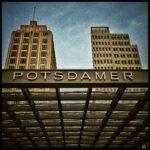The Kurfürstendamm or simply Kudamm as it is commonly known is one of Berlin’s most famous avenues. It is a long, wide avenue lined with shops, hotels, cafés and restaurants. The Kudamm was the commercial centre of West Berlin when the city was divided.
History
The Kurfürstendamm was originally built in the mid-16th century as a horse track so that Prince Joachim II could travel from his palace on Unter den Linden to his hunting lodge in the Grünewald Forest.
On the initiative of Otto von Bismarck, from 1875 onwards the racecourse was transformed into a 53-metre wide boulevard with shops, restaurants and theatres. This was the beginning of the construction of the city’s most sophisticated addresses, many of which can be seen in the parallel streets.
The Kurfürstendamm developed into a cultural, commercial and entertainment centre, reaching its peak in the 1920s.
This golden phase ended with the onset of the economic depression in 1929 and the coming to power of the Nazis. During the Nazi era, there were cultural and political restrictions, which led to changes on the avenue as well. And with the persecution, expulsion and murder of the Jews, who had helped shape the face and identity of the Kurfürstendamm, the old spirit disappeared for good.
The aerial bombardments of the Second World War destroyed many buildings, but reconstruction soon began and, with the division of the city, the Kurfürstendamm, which remained on the western side, became the commercial centre of West Berlin.
In the turbulent political times of the 1960s, the Kurfürstendamm was the scene of major protests and demonstrations. On the night of 9 November 1989, when the wall opened, East Berliners first flocked to the Kudamm, filling its streets. Soon afterwards, the boulevard lost its importance, as attention turned to the old historic centre and the new Potsdamer Platz.
Video
Since the early 2000s, cinemas and some old restaurants have been closed and new hotels built. The boulevard has ceased to be a leisure centre and has become a shopping area, so much so that it is now one of the most popular shopping destinations in Berlin.
A few blocks from the Memorial Church (Gedächtniskirche) you will find the boutiques of more sophisticated and exclusive brands such as Chanel, Cartier, Bulgari, Gucci.
As mentioned above, in the Kudamm or more precisely in the centre of Breitscheidplatz, you will find the Gedächtniskirche, one of the main attractions of Berlin.
This church was severely damaged in the bombings of World War II, leaving only a tower and a small part of it, which have not been restored precisely to remember the consequences of the war. There is a memorial which tells the story of the church, as well as photographs before and after the destruction.
How to get there
S-Bahn: Lines S5, S7 and S75, station S+U Zoologischer Garten (closest to the Gedächtniskirche)
U-Bahn: Line U1, Kurfürstendamm station (closest to Gedächtniskirche) or Uhlandstraße station; Line U9, Kurfürstendamm station or S+U Zoologischer Garten station; Line U2, Wittenbergplatz station (very close to KaDeWe) or S+U Zoologischer Garten
Bus: lines 100, 200, M45, M46, M49, stop S+U Zoologischer Garten; line X10, stops S+U Zoologischer Garten, U Kurfürstendamm, U Uhlandstr. or stop Olivaer Platz (which is the closest stop to the luxury shops)
Address: Kurfürstendamm, 10719 Berlin
https://goo.gl/maps/Z45iQzm4KMPL2xYk8





